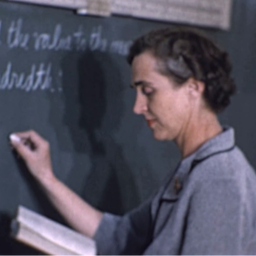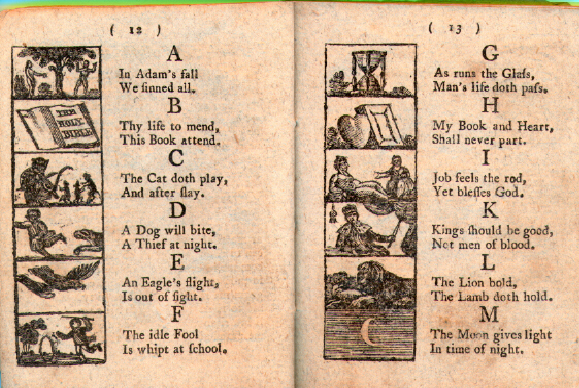 Anyone with a basic understanding of our history knows that the northern states (particularly New England) have felt the need to impose their beliefs on all Americans from the early days of this nation. Education is no different. Going back even to 1642, the state of Massachusetts (knowing better than individual families) passed the first “Compulsory Education” law. This mandated that parents and masters had to instruct children in reading, religion, and the capital laws. Five years later, they passed the “Old Deluder” (a reference to Satan) School Law. This required towns of 50 householders to provide education in reading and writing. Towns with over 100 householders had to establish a grammar school. While this remained a northern method of education, the public school movement became nationwide between the years of 1830-1860. Even the first textbook came from the north. The New England Primer, pictured above, taught children letters and basic grammar using stories from The Bible. In true Yankee know-it-all fashion, Horace Mann (Secretary of the Massachusetts Board of Education and public school propagandist) declared in his 1848 Twelfth Annual Report on education: “The Common School, improved and energized, as it can easily be, may become the most effective and benignant of all forces of civilization.” For many years, Horace Mann had been bragging about the messianic power of tax-supported, nationwide public schools. The truth is that this propaganda is typical of northerners and was simply a mask for intolerance. Many Americans were upset by cultural changes during the mid nineteenth century. Urbanization, industrialization, and immigration (particularly of Roman Catholics) worried many proponents of public schooling. The same “reformers” that touted the power of public schools also feared private schools would sabotage the goals of the public school movement. Private schools became labeled as divisive, non-democratic, and hostile to the public needs. By the 1860s, the once blurry line between public and private schools became more visible. Driven mostly by anti-Catholicism, the northern states of Michigan (1835), New Hampshire (1848), Ohio (1851), Massachusetts (1855), Illinois (1855), California (1855) and New Jersey (1866) terminated government funding of private schools by statute or constitutional provision. Public schooling was becoming more prevalent, especially after the “Civil War.” For example in 1850, out of over sixteen million dollars spent on schools and colleges, only forty seven percent came from the public. By 1870 however, public school spending soared to over ninety-five million, with sixty-five percent coming from the public purse. By the late 1800s, many academies and private schools that did not transform into public schools had to shut down, or re-establish themselves as colleges or elite boarding schools. The difference in educational philosophies of the north and south were drastic. From the beginning, in the 17th century, the education in the south centered around the Church of England. Schools, libraries, and missions were established throughout the South by the Society for the Propagation of the Gospel in Foreign Parts, a branch of the Church of England. Southern indentured servants and even orphans bound to apprenticeship were legally owed an education in reading, writing, and arithmetic. After the American Revolution, education became primarily the responsibility of private individuals in the South. As a result, private academies became extremely popular—with more than two hundred in Virginia, more than one hundred in Georgia (where they were supported by state funds), and ninety in Arkansas. The southern schools focused on classical and humanistic learning and represented many different religions. Most of the agitation for free public schooling was based on the fact that private academies did not attract poor settlers who could not pay fees. What many agitators of the public school movement did not consider was that Horace Mann was successful because he was working in the industrial north, which was far different than the agricultural south that preferred the traditional forms of schooling. The “Civil War” led to the ruin of the south, and its private academy system. State controlled systems, for black and white children, now became the norm throughout the South. During the reconstruction years, one historian notes, that southern state treasuries were robbed “of more than three hundred million and did nothing for education, either state or private, beyond repeated discussions of the advisability of mixing white and negro children in the public schools.” This would be the death of quality education, not just in the south, but in America. The new goal of education in America was not to produce citizens nor good men; instead, the goal became to produce graduates, workers, and consumers. Many Americans, southerners in particular, were opposed to the public school movement early on. Robert Lewis Dabney was one such southerner. Dabney was a theologian and Southern Presbyterian who accurately predicted many of the problems we are facing with public schools today. For example, he advocated homeschooling far before it became a popular alternative to public schools. Before compulsory education laws were issued nationwide, he predicted that mandatory and government-funded education would lead to more crime and lower academic achievement. Consider the following quote by Dabney on the poor track record of government education: “The northern states of the union had previously to the war all adopted the system of universal state schools, and the southern states had not. In 1850, the former had thirteen and a half millions of people and twenty three thousand six hundred and sixty four (23,664) criminal convictions. The South (without state schools) had nine and a half millions, and two thousand nine hundred and twenty one (2,921) criminal convictions—that is to say, after allowing for the difference in population, the ‘educated’ masses were something more than six times more criminal as the ‘uneducated.’ That same year, the North was supporting 114,000 paupers and the South 20,500. The ‘unintelligent’ South was something more than four times as well qualified to provide for its own subsistence than the ‘intelligent North’! But Massachusetts is the native home of the public school in America…in the South, state schoolhouses were unknown, and consequently jails and penitentiaries were on the most confined and humble scale. The North is studded over with grand and costly public school houses and her jails are even more palatial in extent and more numerous than they.” Anyone with experience in the public schools would have a tough time disproving Dabney’s prophecies. Another historian has even stated that Dabney predicted the recent emergence of Goals and Outcome Based Education when he declared that government education “would inevitably lead to an unholy alliance between unions interested in power, textbook manufacturers desirous of a monopoly share of the industry at taxpayer expense, and special interest groups hoping to foist their intellectual anarchy on the children of the nation.” Probably the worst part of all this change is that the spiritual element has been completely removed from schools, seemingly with malice. If we are “one nation, under God” then why is it wrong to pray or practice religion in schools? The fact is, in Dabney’s day, it was both patriotic and common sense to blend faith and education. Moral and social learning went hand-in-hand, and many parents did not really consider education without Christian influences. Human beings are, by nature, spiritual beings. In my opinion, the north and big government may have succeeded in making public schools and minds more secular, but as long as parents are able to direct their children’s lives I have FAITH the south will remain as spiritual as ever.
1 Comment
4/21/2020 04:20:59 am
Public schools may not look like he best, but to me they are okay. I truly hate it when people think lowly of those who are in public schools. There are people who have no idea how hard it is for some to even begin to study. I know that we are not brought up the same, but simple empathy would do. Not everyone who started from a public school will end up with nothing, that is what I believe in.
Reply
Leave a Reply. |
AuthorMichael Martin is a teacher and historian residing in Charleston, South Carolina. He is the author of Southern Grit: Sensing the Siege of Petersburg and his work has been published on The Abbeville Institute, The Imaginative Conservative, and Dixie Heritage. His goal is to shatter the paradigm of centralization and show the world what the Southern Tradition has to offer. Archives
March 2022
|

